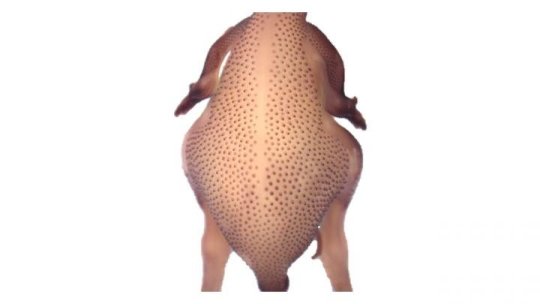[ad_1]
Feathers evolved in dinosaurs and are a key characteristic of birds today. They are arranged in a precise hexagonal pattern in a bird’s skin, but it has been unclear how this happens. According to a new study published February 21 in the open-access journal PLOS Biology, led by Dr. William Ho and Denis Headon of the University of Edinburgh, and collaborative colleagues, the patterning of bird feathers relies on signaling through ectodysplasin (EDA) and its receptor EDAR — the same signaling pathway known to be crucial for the formation of hair follicles, teeth and scales in fish, lizards and mammals.
During a bird’s development, feathers first arise in a row along the middle of the back (the dorsal midline), with rows of new feather buds added sequentially in a spreading wave. Recent studies have shown that natural variation in feather patterning is associated with two pathways involving signaling molecules called fibroblast growth factor (FGF) and bone morphogenetic protein (BMP). To shed further light on this topic, Ho, Headon and colleagues investigated how signaling between cells, changes in cell movement and density, and mechanical processes integrate to drive feather pattern formation.
The researchers show that the patterning of bird feathers relies on coupled FGF and BMP signaling, together with the movement of cells in the dermis (mesenchymal cells). Moreover, a third pathway — EDA/EDAR signaling — is the critical signal driving the wave of patterning, spreading across and interacting with a gradient of mesenchymal cell density. In a mechanical-chemical process, FGF20 induces cells to aggregate, compressing the overlying epidermis to rapidly intensify FGF20 expression. The travelling wave of feather formation is imposed by expanding wave of EDA, which in turn initiates the production of FGF20. The wave of EDA spreads across a gradient of mesenchymal cell density, triggering pattern formation by lowering the threshold of mesenchymal cells required to begin to form a feather bud.
Intriguingly, the researchers found that, in contrast to chickens and ducks, these waves and the precise hexagonal array of their feather patterning have been lost via different developmental routes in the flightless emu and ostrich.
“The formation of feathers has been studied for over 50 years as a model to understand how simple tissues interact to produce organs,” said Headon. “With new technologies we can now watch the process of organ development as it happens, giving deep insights into how the embryonic body produces a complex anatomy through cells both moving and signaling to one another. As we uncover the rules underlying how feather number is determined before hatch in chickens, we can envisage ways to tailor feather density in farmed birds, which can experience overheating, to be appropriate for the climate that they will inhabit.”
Story Source:
Materials provided by PLOS. Note: Content may be edited for style and length.
[ad_2]















